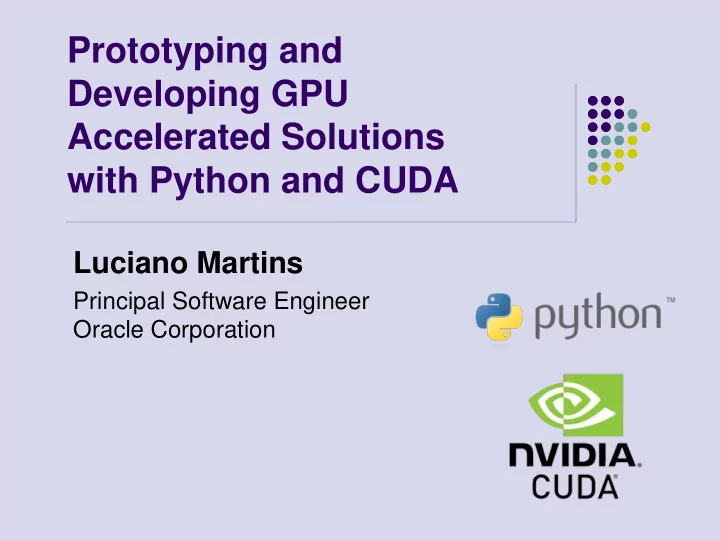

Prototyping and Developing GPU Accelerated Solutions with Python and CUDA Luciano Martins Principal Software Engineer Oracle Corporation
Agenda Python introduction GPU programming Why python with GPU? Accelerating python Comparing codes with/without GPU support Summary
Python introduction created by Guido van Rossum in 1991 "Zen of Python" which: Beautiful is better than ugly Explicit is better than implicit Simple is better than complex Complex is better than complicated Readability counts interpreted language (CPython, JPython, ...) dynamically typed; based on objects
Python introduction small core structure: ~30 keywords ~80 built-in functions indention is a pretty serious thing a huge modules ecosystem binds to many different languages supports GPU acceleration via modules ←
Python introduction
GPU programming “the use of a graphics processing unit (GPU) together with a CPU to accelerate deep learning, analytics, and engineering applications” (NVIDIA) most common GPU accelerated operations: large vector/matrix operations (BLAS) speech recognition computer vision way more
GPU programming
Why python with GPU? Interpreted languages has the reputation of being slow for high performance needs Python needs assistance for those tasks Keep the best of both scenarios: Quick development and prototyping with python Use high processing power and speed of GPU Can deliver quick results for complex projects Gives a business decision choice at the end
Accelerating python GPU + python projects are arising every day Accelerated code may be pure python or adding C code Focusing here on the following modules PyCUDA Numba cudamat cupy scikit-cuda
Accelerating python – PyCUDA A python wrapper to CUDA API Requires C programming knowledge (kernel) Gives speed to python – near zero wrapping Compiles the CUDA code copy to GPU CUDA errors translated to python exceptions Easy installation
Accelerating python – PyCUDA
Accelerating python – PyCUDA
Accelerating python – Numba high performance functions written in Python On-the-fly code generation Native code generation for the CPU and GPU Integration with the Python scientific stack Take advantage of Python decorators No need to write C code Code translation done using LLVM compiler
Accelerating python – Numba
Accelerating python – cudamat provides a CUDA-based python matrix class Primary goal: easy dense matrix manipulation Useful to perform matrix ops on GPU Perform many matrix operations multiplication and transpose Elementwise addition, subtraction, multiplication, and division Elementwise application of exp, log, pow, sqrt Summation, maximum and minimum along rows or columns
Accelerating python – cudamat
Accelerating python – cupy an implementation of NumPy-compatible multi-dimensional array on CUDA Useful to perform matrix ops on GPU CuPy is faster than NumPy in many ways
Recommend
More recommend